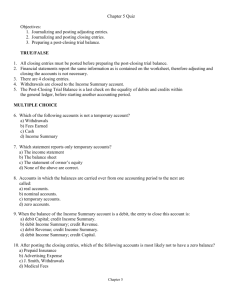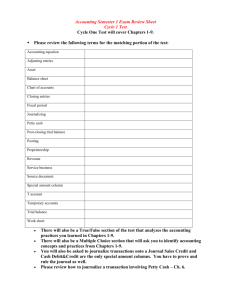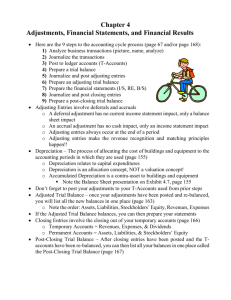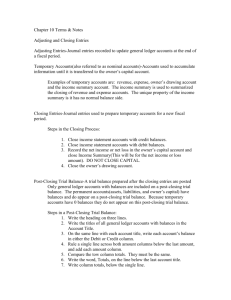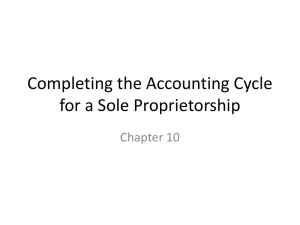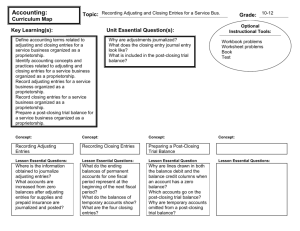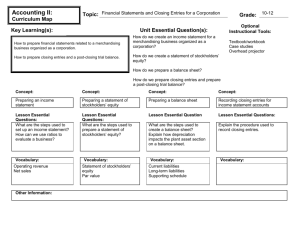CHAPTER 3
advertisement
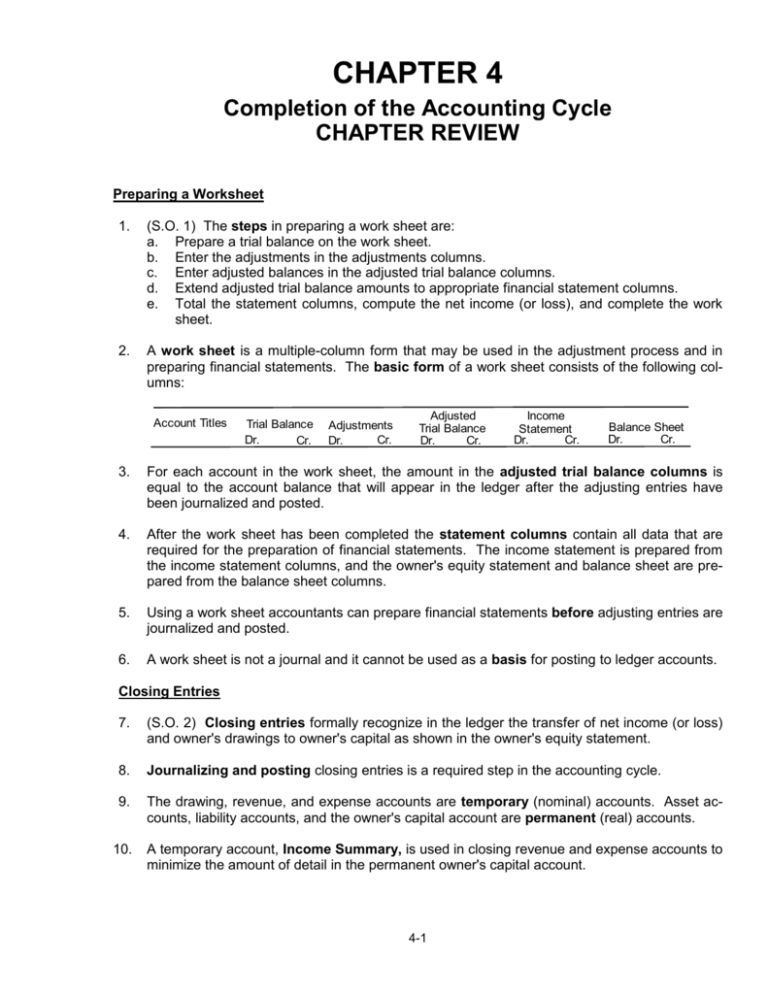
CHAPTER 4 Completion of the Accounting Cycle CHAPTER REVIEW Preparing a Worksheet 1. (S.O. 1) The steps in preparing a work sheet are: a. Prepare a trial balance on the work sheet. b. Enter the adjustments in the adjustments columns. c. Enter adjusted balances in the adjusted trial balance columns. d. Extend adjusted trial balance amounts to appropriate financial statement columns. e. Total the statement columns, compute the net income (or loss), and complete the work sheet. 2. A work sheet is a multiple-column form that may be used in the adjustment process and in preparing financial statements. The basic form of a work sheet consists of the following columns: Account Titles Trial Balance Dr. Cr. Adjustments Cr. Dr. Adjusted Trial Balance Dr. Cr. Income Statement Dr. Cr. Balance Sheet Dr. Cr. 3. For each account in the work sheet, the amount in the adjusted trial balance columns is equal to the account balance that will appear in the ledger after the adjusting entries have been journalized and posted. 4. After the work sheet has been completed the statement columns contain all data that are required for the preparation of financial statements. The income statement is prepared from the income statement columns, and the owner's equity statement and balance sheet are prepared from the balance sheet columns. 5. Using a work sheet accountants can prepare financial statements before adjusting entries are journalized and posted. 6. A work sheet is not a journal and it cannot be used as a basis for posting to ledger accounts. Closing Entries 7. (S.O. 2) Closing entries formally recognize in the ledger the transfer of net income (or loss) and owner's drawings to owner's capital as shown in the owner's equity statement. 8. Journalizing and posting closing entries is a required step in the accounting cycle. 9. The drawing, revenue, and expense accounts are temporary (nominal) accounts. Asset accounts, liability accounts, and the owner's capital account are permanent (real) accounts. 10. A temporary account, Income Summary, is used in closing revenue and expense accounts to minimize the amount of detail in the permanent owner's capital account. 4-1 11. In closing the books of a proprietorship: a. Debit each revenue account for its balance, and credit Income Summary for total revenues. b. Debit Income Summary for total expenses, and credit each expense account for its balance. c. Debit Income Summary, and credit Owner's Capital for the amount of net income; conversely, credit Income Summary and debit Owner's Capital if a net loss exists. d. Debit Owner's Capital for the balance in the Owner's Drawing account and credit Owner's Drawing for the same amount. Post-Closing Trial Balance 12. (S.O. 3) After all closing entries have been journalized and posted, a post-closing trial balance is prepared. The purpose of this trial balance is to prove the equality of the permanent account balances that are carried forward into the next accounting period. Steps in the Accounting Cycle 13. (S.O. 4) The required steps in the accounting cycle are: a. Analyze business transactions. b. Journalize the transactions. c. Post to ledger accounts. d. Prepare a trial balance. e. Journalize and post adjusting entries: Prepayments/Accruals. f. Prepare an adjusted trial balance. g. Prepare financial statements: Income statement, Owner's equity statement, Balance sheet. h. Journalize and post closing entries. i. Prepare a post-closing trial balance. 4-2 LECTURE OUTLINE A. Using a Work Sheet. 1. A work sheet is a multiple-column form that may be used in the adjustment process and in financial statement preparation. 2. The steps in the preparation of a work sheet: a. b. c. Step 1: Prepare a trial balance on the work sheet. Step 2: Enter the adjustments in the adjustment columns. Step 3: Enter the adjusted balances in the adjusted trial balance columns. d. Step 4: Extend the adjusted trial balance amounts to the appropriate financial statement columns. e. Step 5: Total the statement columns, compute the net income (or net loss), and complete the work sheet. 3. A work sheet facilitates the preparation of financial statements because it organizes the account balances and the statements can be prepared before the adjusting entries are journalized and posted. 4. The use of a work sheet is optional and it is essentially a working tool of the accountant. 5. A work sheet is not a journal, and it cannot be used as a basis for posting to ledger accounts. Adjusting entries are recorded in the journal, and then are posted to the ledger accounts. B. Preparing Closing Entries. 1. Closing entries formally recognize in the ledger the transfer of net income (or loss) and owner’s drawings to owner’s capital. Journalizing and posting closing entries is a required step in the accounting cycle. 2. Closing entries produce a zero balance in each temporary account (revenue and expense accounts and owner’s drawing account) so 4-3 that each temporary account may be used to accumulate data in the next accounting period separate from the data of prior periods. 3. There are four closing entries: C. a. Debit each revenue account for its balance and credit Income Summary for total revenues. b. Debit Income Summary for total expenses and credit each expense account for its balance. c. Debit Income Summary and credit Owner’s Capital for the amount of net income (assuming the company had net income). d. Debit Owner’s Capital for the balance in the Owner’s Drawing account and credit Owner’s Drawing for the same amount. Preparing a Post-Closing Trial Balance. 1. The purpose of the post-closing trial balance is to prove the equality of the permanent account balances that are carried forward into the next accounting period. 2. The post-closing trial balance will contain only permanent—balance sheet—accounts since all temporary accounts will have zero balances. D. Summary of the Accounting Cycle. 1. Analyze business transactions. 2. Journalize the transactions. 3. Post to ledger accounts. 4. Prepare a trial balance. 4-4 5. Journalize and post adjusting entries: Prepayments/Accruals. 6. Prepare an adjusted trial balance. 7. Prepare financial statements. 8. Journalize and post closing entries. 9. Prepare a post-closing trial balance. 4-5 4-6 4-7 4-8 4-9 4-10 4-11 4-12 4-13 4-14 4-15 4-16
